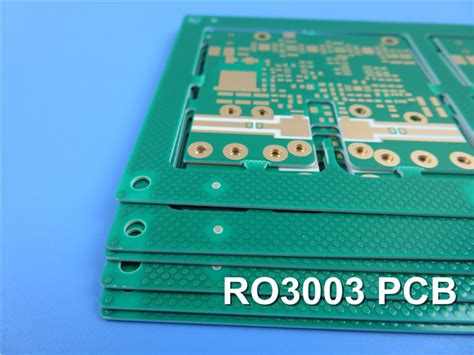Key Features of Rogers PCB
High-Frequency Performance
One of the primary advantages of Rogers PCB materials is their excellent high-frequency performance. These materials exhibit low dielectric loss and stable dielectric constant over a wide range of frequencies, making them ideal for applications operating in the microwave and millimeter-wave ranges.
Some of the popular Rogers PCB materials and their key features are:
| Material | Dielectric Constant | Dissipation Factor | Thermal Conductivity (W/m·K) |
|---|---|---|---|
| RO3003 | 3.00 ± 0.04 | 0.0010 | 0.50 |
| RO4350B | 3.48 ± 0.05 | 0.0037 | 0.62 |
| RO4003C | 3.38 ± 0.05 | 0.0027 | 0.71 |
| RT/duroid 5880 | 2.20 ± 0.02 | 0.0009 | 0.20 |
These low-loss materials help minimize signal attenuation and distortion, enabling cleaner and more reliable signal transmission in high-frequency applications.
Thermal Management
Rogers PCB materials also offer excellent thermal management properties. Many of these materials have higher thermal conductivity compared to traditional FR-4, allowing for better heat dissipation and temperature stability. This is particularly important in high-power applications, where efficient heat transfer is essential to ensure the longevity and reliability of the electronic components.
Thermal Conductivity Comparison
| Material | Thermal Conductivity (W/m·K) |
|---|---|
| FR-4 | 0.3 |
| RO4003C | 0.71 |
| RT/duroid 6035HTC | 1.44 |
The higher thermal conductivity of Rogers PCB materials helps prevent hotspots and thermal runaway, contributing to the overall stability and performance of the electronic system.
Mechanical Stability
Rogers PCB materials are engineered to provide excellent mechanical stability, even in challenging environmental conditions. These materials have a low coefficient of thermal expansion (CTE), which minimizes the risk of warping, twisting, or delamination due to temperature fluctuations.
Some Rogers PCB materials, such as RO4835, are specially designed to have a CTE that closely matches that of copper. This ensures better dimensional stability and reduces the stress on the copper traces during thermal cycling, enhancing the reliability and longevity of the PCB.
Multilayer Capability
Rogers PCB materials are well-suited for multilayer PCB designs. The stable dielectric constant and low loss tangent of these materials allow for the creation of complex, high-density interconnects without compromising signal integrity. Multilayer Rogers PCBs are commonly used in advanced electronic systems, such as phased array antennas, where precise control over the signal path and impedance is critical.
Applications of Rogers PCB
Rogers PCBs find applications in various industries and sectors, including:
- Wireless Communication:
- 5G networks
- Cellular base stations
- WiFi and Bluetooth devices
- Internet of Things (IoT) devices
- Aerospace and Defense:
- Radar systems
- Satellite communication
- Avionics
- Military communication equipment
- Automotive:
- Advanced driver assistance systems (ADAS)
- Vehicle-to-vehicle (V2V) communication
- Autonomous vehicles
- In-vehicle infotainment systems
- Medical:
- Medical imaging equipment (MRI, CT, PET)
- High-frequency ultrasound devices
- Wearable medical devices
- Wireless medical telemetry
- Industrial:
- Industrial automation and control systems
- High-speed data acquisition
- Power electronics
- Oil and gas exploration equipment

Designing with Rogers PCB
When designing with Rogers PCB materials, there are several considerations to keep in mind to ensure optimal performance and reliability:
Material Selection
Choosing the right Rogers PCB material depends on the specific requirements of the application, such as the operating frequency, power handling, and environmental conditions. Factors to consider include:
- Dielectric constant and dissipation factor
- Thermal conductivity and CTE
- Mechanical properties and dimensional stability
- Cost and availability
Consulting with Rogers Corporation or an experienced PCB manufacturer can help in selecting the most suitable material for a given application.
Manufacturing Process
Manufacturing Rogers PCBs requires specialized processes and expertise due to the unique properties of the materials. Some key aspects to consider during the manufacturing process include:
- Proper handling and storage of the materials
- Optimized drilling and routing parameters
- Controlled impedance management
- Specialized bonding and lamination techniques
- Stringent quality control and testing procedures
Working with a PCB manufacturer experienced in handling Rogers materials is essential to ensure the highest quality and reliability of the final product.
Signal Integrity Analysis
Conducting thorough signal integrity analysis is crucial when designing high-frequency Rogers PCBs. This involves:
- Impedance matching and control
- Minimizing signal reflections and crosstalk
- Analyzing the impact of vias and transitions
- Optimizing the layout for minimal signal loss and distortion
Using advanced PCB design software with built-in signal integrity analysis tools can help optimize the design and ensure robust performance.
Thermal Management
Proper thermal management is essential for Rogers PCBs, especially in high-power applications. Some strategies for effective thermal management include:
- Selecting a Rogers material with appropriate thermal conductivity
- Incorporating thermal vias and heat spreaders
- Optimizing the component placement and layout for efficient heat dissipation
- Using thermal simulation tools to identify and address potential hotspots
By addressing thermal management early in the design process, designers can ensure the long-term reliability and performance of the Rogers PCB.

FAQ
- Q: What are the main benefits of using Rogers PCB materials over traditional FR-4?
A: Rogers PCB materials offer superior high-frequency performance, better thermal management, and enhanced mechanical stability compared to traditional FR-4. These properties make Rogers PCBs ideal for applications that demand high signal integrity, reliability, and performance in challenging environments. - Q: Can Rogers PCBs be used for multilayer designs?
A: Yes, Rogers PCB materials are well-suited for multilayer PCB designs. The stable dielectric constant and low loss tangent of these materials enable the creation of complex, high-density interconnects without compromising signal integrity. - Q: How do I select the right Rogers PCB material for my application?
A: Choosing the right Rogers PCB material depends on several factors, such as the operating frequency, power handling requirements, and environmental conditions. Consider the dielectric constant, dissipation factor, thermal conductivity, and mechanical properties when making your selection. Consulting with Rogers Corporation or an experienced PCB manufacturer can help you make an informed decision. - Q: Are there any special considerations when manufacturing Rogers PCBs?
A: Yes, manufacturing Rogers PCBs requires specialized processes and expertise due to the unique properties of the materials. Proper handling, storage, drilling, routing, bonding, and lamination techniques are essential to ensure the highest quality and reliability of the final product. It is recommended to work with a PCB manufacturer experienced in handling Rogers materials. - Q: What industries commonly use Rogers PCBs?
A: Rogers PCBs are used in various industries, including wireless communication, aerospace and defense, automotive, medical, and industrial sectors. Applications range from 5G networks, radar systems, and satellite communication to advanced driver assistance systems, medical imaging equipment, and industrial automation.
In conclusion, Rogers PCBs offer a range of benefits over traditional FR-4 materials, making them an ideal choice for high-frequency, high-reliability applications across various industries. By understanding the key features and design considerations of Rogers PCBs, engineers and designers can create cutting-edge electronic systems that push the boundaries of performance and innovation.


No responses yet